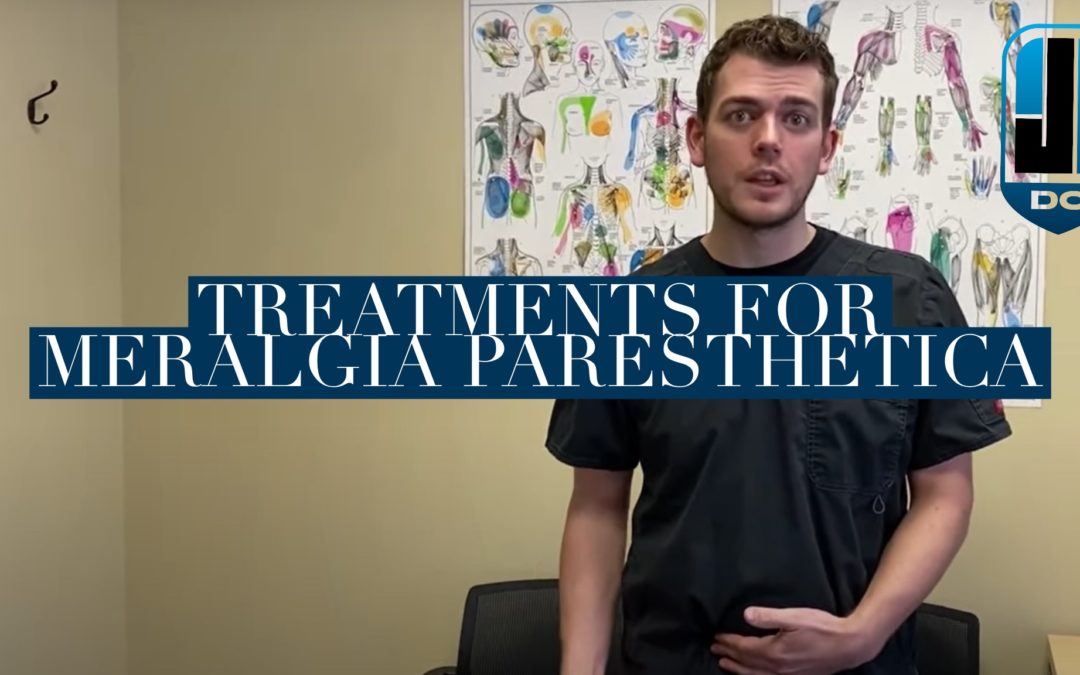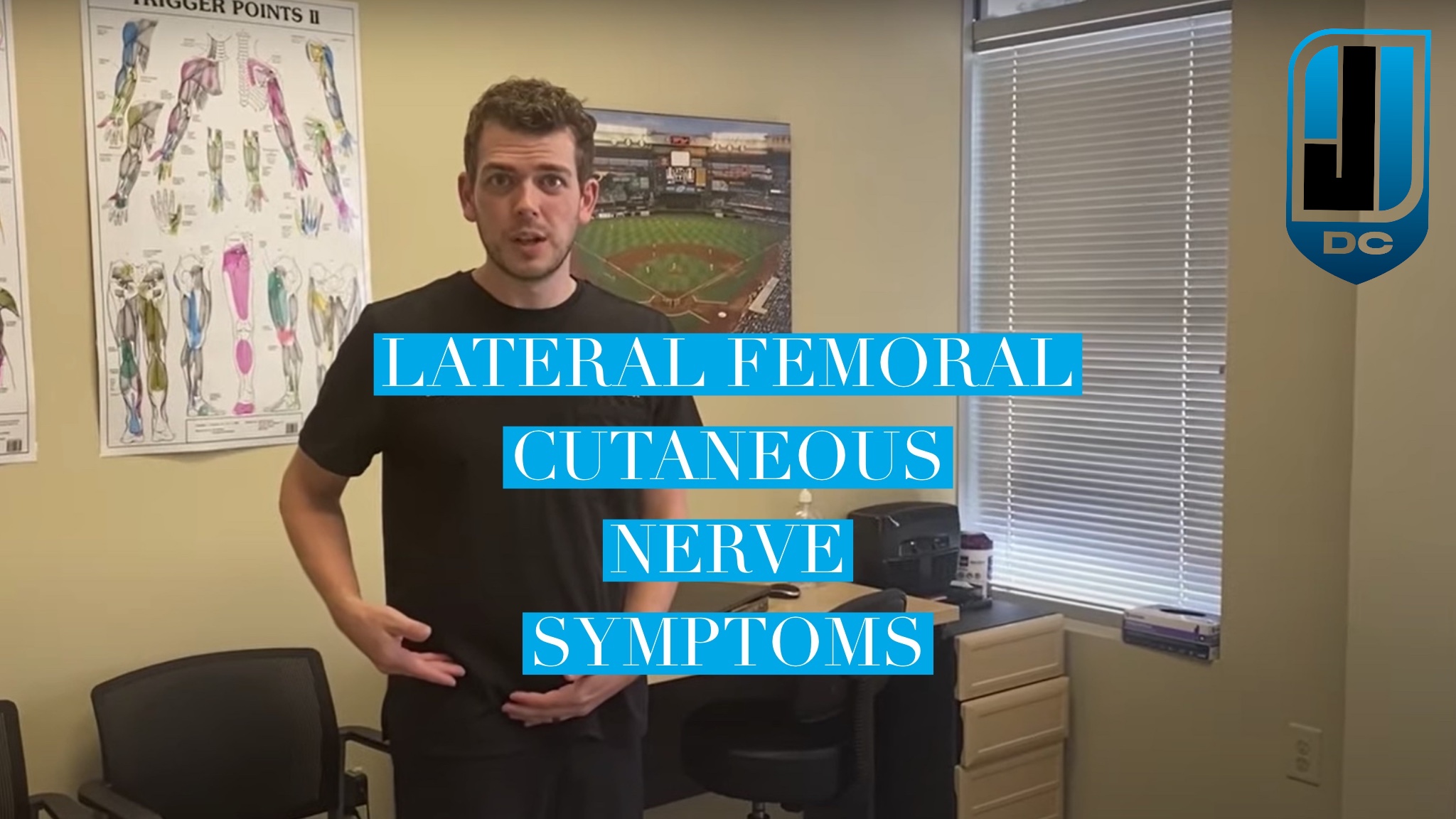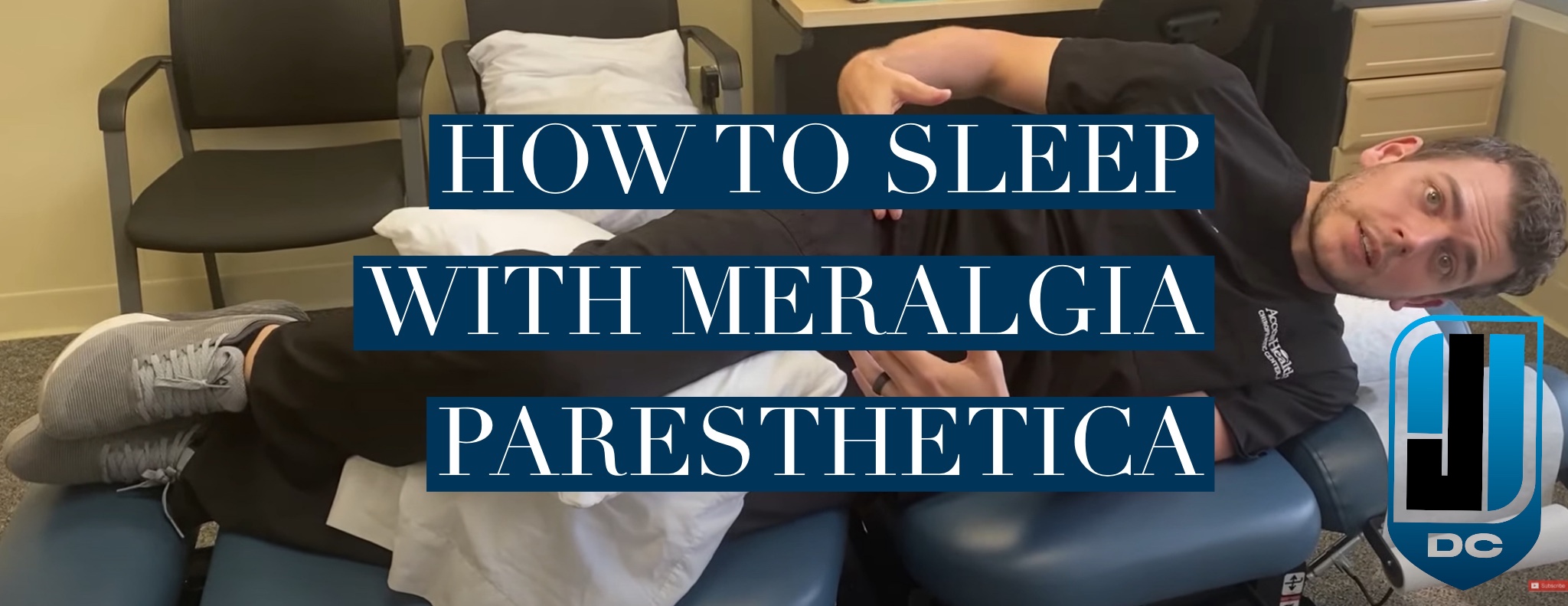There are many treatments for Meralgia Paresthetica ranging from chiropractic care, standard medical care, or even surgery. If you’re struggling with Lateral Femoral Cutaneous Nerve pain, the good news is that the majority of cases will resolve with the right treatment. Even simple lifestyle changes and home exercises for Meralgia Paresthetica may be enough to relieve your symptoms. This blog is part 3 of 3 where I answer ALL your questions about Meralgia Paresthetica and the Lateral Femoral Cutaneous Nerve. In this one I’ll answer:
- What is the BEST treatment for Meralgia Paresthetica?
- How to relieve Meralgia Paresthetica at home?
- What are home treatments for Meralgia Paresthetica?
- What are medical treatments for Meralgia Paresthetica?
If you’re struggling with Meralgia Paresthetica, make sure you read my other content. In it I discuss the condition and answer a lot of your other questions about it.
Part 1: What is Meralgia Paresthetica?
- What is Meralgia Paresthetica?
- What does the Lateral Femoral Cutaneous Nerve do?
- What does Meralgia Paresthetica feel like?
- Is Meralgia Paresthetica more common in certain people?
- What causes Meralgia Paresthetica?
- Can posture changes cause Meralgia Paresthetica?
Part 2: Lateral Femoral Cutaneous Nerve Symptoms
- What are Lateral Femoral Cutaneous Nerve Symptoms?
- What are simple tests for Meralgia Paresthetica?
- Is burning in your thigh Meralgia Paresthetica or something else?
- Do I need an MRI if I have Meralgia Paresthetica?
- What conditions can mimic Lateral Femoral Cutaneous Nerve pain?
What is the Best Treatment for Meralgia Paresthetica?
The good news is that the best treatment for Meralgia Paresthetica is what’s called conservative care. It’s the recommended frontline treatment because it’s safe and low cost. Conservative care includes chiropractic care or physical therapy. My personal opinion is that chiropractors offer the greatest variety of treatment options and expertise to help relieve symptoms of this condition. Conservative care has an estimated success rate of 91%, so it’s very likely that with the right care you can overcome this condition.
In order to get relief from Meralgia Paresthetica the goal is to reduce compression or traction on your Lateral Femoral Cutaneous nerve. These are some of the treatments that I typically use for this condition at the integrated chiropractic office I practice at:
- Pelvic and core stabilization exercises to address any stabilization and motor control issues that show up when I do the SFMA as part of your exam.
- Joint manipulation and mobilization to address any mobility deficits I find and help relieve some of your discomfort.
- Stretches to improve tissue flexibility and joint mobility in key areas that are contributing to the condition.
- Dry needling to normalize muscle tone and reduce myofascial trigger points in the hip, back, and thigh.
Not only are the treatments that chiropractors offer effective, but they’re really safe in comparison to alternative. I’d encourage you to see a great rehab-focused chiropractor before anyone else if you have Meralgia Paresthetica symptoms. If you want to see me, I’m a chiropractor in Dumfries, VA at Sentara Therapy Center.
How to Relieve Meralgia Paresthetica at Home?
To relieve Meralgia Paresthetica at home, it’s worth trying some lifestyle changes that may help you. If your symptoms are new, they may resolve with these simple changes. Here’s some of the lifestyle advice I give my patients:
- Wear looser fitting clothing and stop wearing a belt temporarily to relieve any compression over the Lateral Femoral Cutaneous nerve.
- If you’re wearing a tool belt stop wearing it right now and give the hip and thigh a chance to heal.
- Stop wearing high heels or footwear that lifts your heels. These types of footwear promote anterior pelvic tilt and create tension and ultimately compression over the Lateral Femoral Cutaneous nerve.
- Selectively avoid repetitive hip flexion (lifting your hip up towards your chest) as best as you can for a period of time. You flex your hips to some extent every day when you’re walking, but if you’re squatting or sitting for longer periods of the day try to modify it.
- Make a serious effort to lose weight if you’re overweight, especially if you’re experiencing Meralgia Paresthetica after weight gain.
- Find the best sleeping position for Meralgia Paresthetica. Using pillows strategically and sleeping in positions that don’t compress the Lateral Femoral Cutaneous nerve are important for long-term recovery. I will show you the best sleeping positions for Meralgia Paresthetica in this video.
Can’t Sleep with Meralgia Paresthetica?
Read my recommendations on how to sleep with Meralgia Paresthetica. I cover the 3 best sleeping positions to relieve pain in the Lateral Femoral Cutaneous Nerve.
What are Home Treatments for Meralgia Paresthetica?
I also recommend some home treatments to patients who are getting chiropractic care for Meralgia Paresthetica. Lifestyle changes are huge, but there are a few other things you can do to speed up recovery time and promote healing for the burning and tingling in the front of the thigh.
- Using an ice pack over the inguinal area (right where the crease is in the front of your hip) for 10-20 minutes a few times a day. This can help reduce inflammation around the Lateral Femoral Cutaneous nerve and provide symptomatic relief for the thigh burning and tingling.
- I’m not a medical doctor so I don’t write prescriptions or make recommendations on medicine, but some patients find NSAIDs provide relief after being advised by their MD.
- Stretches for Meralgia Paresthetica can help loosen up tight muscles, promote mobility, and relieve discomfort.
- Exercises for Meralgia Paresthetica help correct stability and motor control issues that are leading to pain in the front of the thigh. Being consistent with the right exercises can help relieve pain and get you back to your daily activities as soon as possible.
What are Medical Treatments for Meralgia Paresthetica?
The best treatment for Meralgia Paresthetica is chiropractic care and physical therapy from a reputable provider who has experience with the condition. As a provider who treats using chiropractic care for Meralgia Paresthetica, I’ve seen the vast majority of cases resolve. In the rare cases that the thigh burning, tinging, and pain doesn’t resolve with chiropractic care or physical therapy, I refer to the appropriate provider. Typically, the referral is to an orthopedic medical doctor, pain specialist, or PM&R doctor. Here are some of the medical treatments your doctor may suggest:
- Nerve blocks where an injection of an anti-inflammatory medication is strategically placed at the area of compression of the Lateral Femoral Cutaneous nerve.
- A steroid injection, or series of injections, to reduce the inflammation that is causing the thigh burning and tingling in Meralgia Paresthetica.
- Surgical decompression of the area where the LFCN is being compression, inflamed, and irritated.
- Lateral Femoral Cutaneous nerve resection where a surgeon removes the sensory nerve that is causing your symptoms.
These last two medical procedures have high success rates in relieving Meralgia Paresthetica thigh pain, but still don’t have the effectiveness of conservative care (91% effective) like chiropractic care and physical therapy. That’s why I always recommend chiropractic care for Meralgia Paresthetica to my patients first, and again, the vast majority of the time the pain resolves with a course of care.
I really hope my content has been helpful, but there’s one last thing it’s important for me to tell you. If you’re suffering from Meralgia Paresthetica you CAN find relief. I’m a big proponent of the chiropractic and rehab treatments that I discussed because I’ve seen them work, but even when they don’t you have other options. Remain positive and never be afraid to find someone to help.

Jason Williams DC is a licensed Doctor of Chiropractic with Physical Therapy Modality and Acupuncture privileges. He is a chiropractor in Dumfries, VA at Sentara Therapy Center. Dr. Williams’ clinical expertise is in the evaluation, treatment, and rehabilitation of neuro-musculoskeletal conditions. Specific focuses include spinal, extremity, and sports-related complaints. He brings a patient-first attitude to his treatments and is a proponent of evidence-based and integrative care. See more content and his contact info here.
The opinions and views are mine personally, and do not necessarily reflect the views of others in the profession, my employer, or organizations that I belong to.




